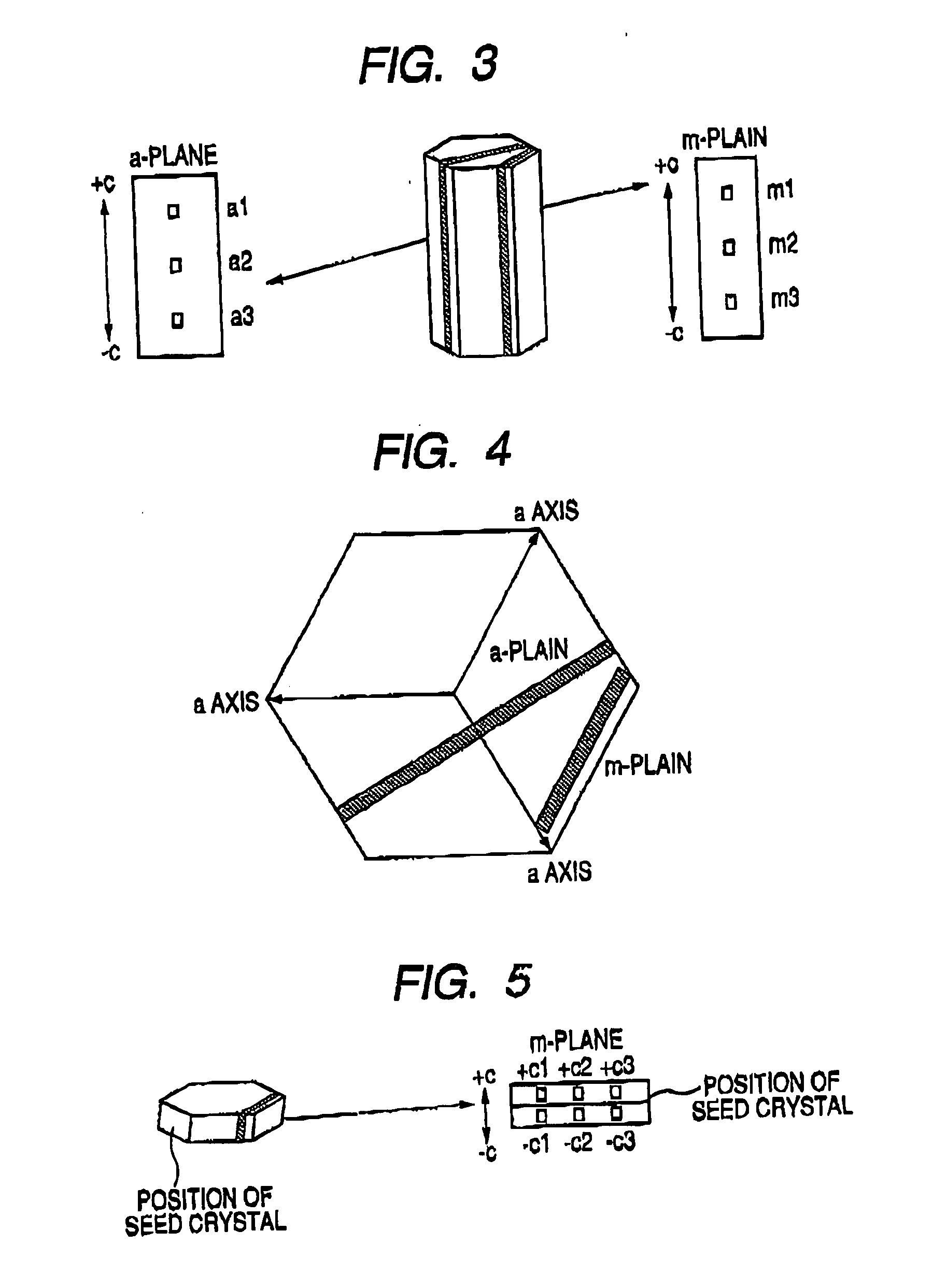Hexagonal Wurtzite Type Single Crystal, Process For Producing The Same, And Hexagonal Wurtzite Type Single Crystal Substrate
a technology of hexagonal wurtzite and single crystal, which is applied in the direction of crystal growth process, polycrystalline material growth, gel state, etc., can solve the problems of difficult to keep a stoichiometric mixture ratio, high pressure and high temperature condition of growth of crystal obtained thereby, and achieve excellent uniformity of impurity concentration and low impurity concentration. , the effect of low impurity concentration
- Summary
- Abstract
- Description
- Claims
- Application Information
AI Technical Summary
Benefits of technology
Problems solved by technology
Method used
Image
Examples
example 1
[0085] After ZnO powders having a purity of 99.9999% were compacted in a molding vessel and sintered at 1100° C. for 24 hours, the solid thus obtained was filled in the growth vessel 20. Purified water in which 1 mol / l of LiOH and 3 mol / l of KOH had been dissolved as a mineralizer was poured in 80% of the free capacity of the growth vessel 20 and then 0.05 mol / l of H2O2 was poured therein further. The growth vessel 20 and bellows were welded to completely seal the growth vessel 20. For the thermal conductivity between the autoclave 12 (φ200×300 mm) and the growth vessel 20, purified water was filled therein in an amount of 80% of the free capacity. The autoclave 12 comprising a vessel body 13 and a lid 14 was made airtight by placing the lid 14 on the vessel body 13 via a packing 17 and fixing them with a fixing member 15.
[0086] The dissolution region (having the same meaning as the raw material filling portion, which will equally apply hereinafter) and the growth region (having th...
example 2
[0089] In a similar manner to Example 1 except that a final temperature difference between the raw material filling portion and crystal growth portion was set at 45° C., crystal growth of ZnO was performed. Described specifically, the temperature of the dissolution region was made greater by 35 to 45° C. than the temperature of the growth region and heating was conducted to give the final temperature of the dissolution region of 390° C. and that of the growth region of about 345° C. As a result, a crystal having a size of 60 mm (a)×10 mm (m)×20 mm (c) and having high transparency was obtained (in which, a, m and c represents the directions of respective axes). Analysis results of metal concentrations in regions N-1 to N-3 of the sample cut in FIG. 6 by a similar method to that employed in Example 1 are shown in Table 2. The results suggest that the concentration of Fe is 1.3 ppm or less, that of Al is 0.5 ppm or less and that of Mg is 0.1 ppm or less and a variation in the concentra...
example 3
[0090] In a similar manner to Example 1 except that a final temperature difference between the raw material filling portion and crystal growth portion was set at 17° C., crystal growth of ZnO was performed. Described specifically, the temperature of the dissolution region was made greater by from 10 to 20° C. than the temperature of the growth region and heating was conducted to give the final temperature of the dissolution region of 355° C. and that of the growth region of about 338° C. As a result, a crystal having a size of 28 mm (a)×11.5 mm (m)×14 mm (c) and colored in green was obtained (in which, a, m and c represents the directions of respective axes). Analysis results of metal concentrations in regions O-1 to O-4 of the sample cut as in FIG. 7 by a similar method to that employed in Example 1 are shown in Table 2. The results suggest that the variation in each metal concentration within the same plane was within 100%, but the sample contained Fe, Al and Mg in a relatively la...
PUM
 Login to View More
Login to View More Abstract
Description
Claims
Application Information
 Login to View More
Login to View More - R&D
- Intellectual Property
- Life Sciences
- Materials
- Tech Scout
- Unparalleled Data Quality
- Higher Quality Content
- 60% Fewer Hallucinations
Browse by: Latest US Patents, China's latest patents, Technical Efficacy Thesaurus, Application Domain, Technology Topic, Popular Technical Reports.
© 2025 PatSnap. All rights reserved.Legal|Privacy policy|Modern Slavery Act Transparency Statement|Sitemap|About US| Contact US: help@patsnap.com



